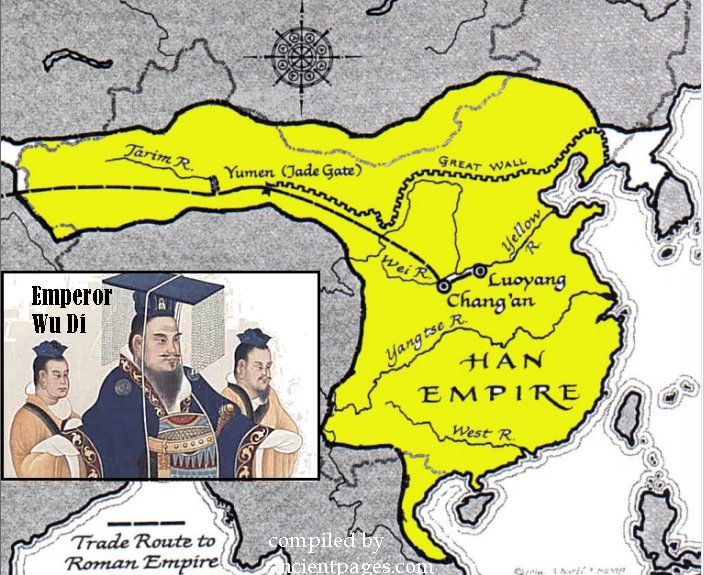What Is Pax Sinica?
AncientPages.com - Pax Sinica (in Latin:"Chinese peace") was similar in its meaning to Pax Romana, and it applied to the period of peace in East Asia, maintained by social, cultural, ideological, or economic influence of China.
The Pax Sinica is considered the Chinese version of the Romans' Pax Romana, a period of relative peace and stability across the Roman Empire which lasted for over 200 years.
When the high-ranking emperor of Han, Liu Pang (202 – 195 BC) founded the Han Dynasty in 202 BC, the Chinese began to experience a 400 year period of peace, known as the Pax Sinica.
It had various ways to manifest itself but it first of all concentrated on some basic innovations that were of great importance for the country.
The Han rulers established a strong central government formed of carefully chosen candidates instead of members of the royal family.
The government had to work in the people’s interest. It helped and protected the Chinese citizens, mainly by peace and prosperity.
See also:
Pax Romana: 200-Year-Long Period Of Stability Within The Roman Empire
Pax Mongolica: Time Of Peace And Stability That Helped To Spread Technologies And Inventions
Pax Assyriaca: Important Time For The Neo Assyrian Empire And Surrounding Regions
Among several introduced innovations was the storage of remaining food during times of plenty and selling it during difficult times. It stabilized both prices and feeding the public.
During this time, the Great Wall of China was built, the long-distance travel and trade, which was used to trade silk, spices, and tea with the Roman Empire, also prospered on the Silk Road.
During the Pax Sinica, several developments of the Han Dynasty took place such as the civil service, the first papermaking process was documented in China during the Eastern Han period (25–220 AD). In 140 BC, the land expanded due to conquests of Korea, Manchuria, and Vietnam by Han emperor, Han Wudi.
After the Han Dynasty ended in 220 AD, the Pax Sinica continued during a period of the next six dynasties (the Western Zhou, Tang, Western Han, Eastern Han, Ming, and Qing dynasties), which lasted for over 350 years.
As we said, the Pax Sinica introduced by Han dynasty of China coincided with the Pax Romana of the western world by Rome.
Copyright © AncientPages.com All rights reserved. This material may not be published, broadcast, rewritten or redistributed in whole or part without the express written permission of AncientPages.com
More From Ancient Pages
-
 Giulia Tofana Poisoned 600 Men – Beautiful Sicilian Woman And Her Deadly Mission
Featured Stories | Feb 22, 2018
Giulia Tofana Poisoned 600 Men – Beautiful Sicilian Woman And Her Deadly Mission
Featured Stories | Feb 22, 2018 -
 1,000-Year-Old Church Walls Unearthed In Ethiopia By Polish Archaeologists
Archaeology | Apr 26, 2020
1,000-Year-Old Church Walls Unearthed In Ethiopia By Polish Archaeologists
Archaeology | Apr 26, 2020 -
 Mysterious Hornet Spook Light In Missouri
Featured Stories | Apr 22, 2020
Mysterious Hornet Spook Light In Missouri
Featured Stories | Apr 22, 2020 -
 World’s Oldest Human Statue Discovered At Karahan Tepe, Turkey
Archaeology | Oct 30, 2023
World’s Oldest Human Statue Discovered At Karahan Tepe, Turkey
Archaeology | Oct 30, 2023 -
 Howard Carter Stole Tutankhamun’s Treasures – Previously Unpublished Letter Reveals
Archaeology | Aug 15, 2022
Howard Carter Stole Tutankhamun’s Treasures – Previously Unpublished Letter Reveals
Archaeology | Aug 15, 2022 -
 Odd Ancient Dwellings Of The Snake People – American-European Connection Part 1
Featured Stories | Sep 6, 2020
Odd Ancient Dwellings Of The Snake People – American-European Connection Part 1
Featured Stories | Sep 6, 2020 -
 Remains Of A Roman Ship Discovered In Serbia
Archaeology | Aug 7, 2023
Remains Of A Roman Ship Discovered In Serbia
Archaeology | Aug 7, 2023 -
 What Is The Curse Of The Ninth Symphony?
Ancient History Facts | Aug 3, 2018
What Is The Curse Of The Ninth Symphony?
Ancient History Facts | Aug 3, 2018 -
 Ancient Maya Reservoirs Contained Toxic Pollution – New Study
Archaeology | Jun 27, 2020
Ancient Maya Reservoirs Contained Toxic Pollution – New Study
Archaeology | Jun 27, 2020 -
 Three Judges Of Souls Await You On Chinvat Bridge – Gateway To Unknown Realms In Zoroastrian Beliefs
Featured Stories | Aug 11, 2021
Three Judges Of Souls Await You On Chinvat Bridge – Gateway To Unknown Realms In Zoroastrian Beliefs
Featured Stories | Aug 11, 2021 -
 Ancient Egyptian Mummies With Golden Tongues Discovered In Alexandria
Archaeology | Feb 3, 2021
Ancient Egyptian Mummies With Golden Tongues Discovered In Alexandria
Archaeology | Feb 3, 2021 -
 Ancient Egyptians Observed Algol’s Eclipses – Cairo Calendar Analyzed
Archaeology | Dec 19, 2015
Ancient Egyptians Observed Algol’s Eclipses – Cairo Calendar Analyzed
Archaeology | Dec 19, 2015 -
 This Ancient Roman Painting Survived Eruption Of Mount Vesuvius In 79 A.D.
Archaeology | Aug 21, 2017
This Ancient Roman Painting Survived Eruption Of Mount Vesuvius In 79 A.D.
Archaeology | Aug 21, 2017 -
 Statue Of Gudea: The King-Priest Of Sumerian City Of Lagash In Southeast Mesopotamia
Featured Stories | Aug 14, 2016
Statue Of Gudea: The King-Priest Of Sumerian City Of Lagash In Southeast Mesopotamia
Featured Stories | Aug 14, 2016 -
 2000-Year-Old Tomb Discovered In Northwestern China
Archaeology | Dec 7, 2015
2000-Year-Old Tomb Discovered In Northwestern China
Archaeology | Dec 7, 2015 -
 Legendary Viking Sunstones Did Exist: Viking Sagas Were More Truthful Than We Realized
Featured Stories | Sep 15, 2023
Legendary Viking Sunstones Did Exist: Viking Sagas Were More Truthful Than We Realized
Featured Stories | Sep 15, 2023 -
 Why Was Napoleon Bonaparte Defeated At Waterloo?
Ancient History Facts | Jul 3, 2017
Why Was Napoleon Bonaparte Defeated At Waterloo?
Ancient History Facts | Jul 3, 2017 -
 Rare, Well-Preserved Medieval Bone Flute Found In Kent
Archaeology | Nov 24, 2022
Rare, Well-Preserved Medieval Bone Flute Found In Kent
Archaeology | Nov 24, 2022 -
 2,700-Year-Old Ceramic Sculpture Of Goddess Found In Aegean Sea
Archaeology | Feb 28, 2017
2,700-Year-Old Ceramic Sculpture Of Goddess Found In Aegean Sea
Archaeology | Feb 28, 2017 -
 Laocoon – A Trojan Priest Who Offended The Gods And Was Strangled By Sea Serpents
Featured Stories | Nov 15, 2021
Laocoon – A Trojan Priest Who Offended The Gods And Was Strangled By Sea Serpents
Featured Stories | Nov 15, 2021

